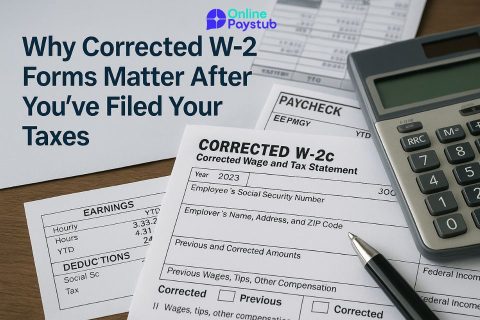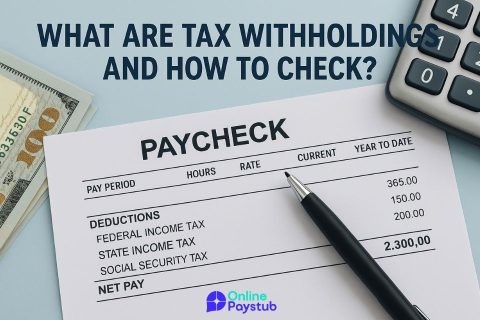A W-2 form, officially titled “Wage and Tax Statement,” is issued by an employer to both the employee and the Internal Revenue Service (IRS) at the end of each tax year. It provides a detailed account of an employee’s earnings and the corresponding withholdings for federal, state, and local taxes. This document serves as a primary record in annual income reporting and is a regulatory requirement for most salaried employment arrangements.
Each W-2 form captures critical components including taxable wages, Social Security contributions, Medicare wages, and tax amounts withheld across various jurisdictions. Additionally, it includes other compensation details such as dependent care benefits, deferred compensation, and employee retirement plan participation. These entries allow both the employee and tax authorities to verify the accuracy of reported income and deductions.
In compliance with federal law, employers must provide this form to employees by the end of January following the close of the tax year. Failure to file with accurate W-2 data can result in filing delays, audits, or monetary penalties. For individuals relying on digital tax software or professional filing services, the structured format of the W-2 allows for seamless data integration and automated calculation of total tax liability.
Beyond regulatory necessity, the W-2 form serves as a foundation for evaluating employer contributions, confirming benefits enrollment, and reconciling year-end paystub information. Its utility spans personal financial audits, loan applications, and benefits verifications. This makes precise interpretation of each field not just a tax obligation but a matter of broader financial literacy.
The Critical Differences Between Box 1, Box 3, and Box 5 Explained
Box 1, Box 3, and Box 5 on the W-2 form each represent distinct classifications of income, and understanding their differences is essential for accurate tax filing and financial planning. These boxes do not contain identical figures, as they are governed by separate tax rules and withholding criteria.
Box 1 reflects taxable wages for federal income tax purposes. This includes regular salary, bonuses, and the value of certain fringe benefits. However, it excludes contributions to employer-sponsored retirement plans and pre-tax benefits such as health insurance or flexible spending accounts. This figure directly influences the amount of federal tax owed or refunded.
Box 3 shows wages subject to Social Security tax. The calculation of this figure differs from Box 1 because some pre-tax deductions, like retirement contributions, are included here. However, Social Security wages are capped annually by the IRS, and any income exceeding that threshold is not subject to this tax. This cap introduces complexity when comparing multiple income sources or changes across years.
Box 5 represents wages subject to Medicare tax. Unlike Box 3, Medicare wages are not subject to an annual income cap. This amount includes pre-tax retirement contributions but excludes certain other pre-tax deductions. Employees earning above a specified threshold are also subject to an additional Medicare surtax, further distinguishing this box from the others.
Each of these boxes captures a unique aspect of income: taxable income for federal reporting, income subject to Social Security limits, and income exposed to uncapped Medicare taxation. Misunderstanding these distinctions can lead to miscalculations in estimated taxes, underreporting of income, or confusion during benefit audits. A precise interpretation of these values ensures consistency across paystubs, tax filings, and official income verification processes.
Understanding Federal Income Tax Withholding Through Box 2
Box 2 on the W-2 form displays the total amount of federal income tax that has been withheld from an employee’s earnings over the course of the tax year. This figure is not a direct reflection of what is ultimately owed but rather a running total of prepayments made toward the employee’s federal tax liability.
The amount listed in Box 2 is calculated based on several variables, including filing status, number of allowances claimed on the W-4 form, and the employee’s total taxable income. Employers are required to withhold this tax on a per-pay-period basis, applying the IRS’s published withholding tables, which account for both income level and anticipated tax credits.
This withholding operates as a pay-as-you-earn system, which reduces the likelihood of a large tax bill at the end of the year. Instead, the amounts paid throughout the year through Box 2 are reconciled with the actual tax obligation when the individual files a federal return. If too much has been withheld, the result is a refund. If too little has been withheld, the difference must be paid.
Proper evaluation of Box 2 is crucial when attempting to assess whether the correct amount of tax has been withheld. Changes in income, employment, or exemptions can lead to under- or over-withholding. Comparing Box 2 across years or against estimated tax calculators allows individuals to adjust their W-4 settings strategically.
Federal income tax withholding in Box 2 is a dynamic figure, influenced by evolving personal and financial circumstances. Treating it as a static or self-contained number can lead to misunderstandings during filing or when projecting future obligations. An informed review helps align actual payments with the final tax position, minimizing surprises at year-end.
The Role of Employer EIN and Why It Shouldn’t Be Overlooked
The Employer Identification Number (EIN), located in Box B of the W-2 form, serves as the unique identifier assigned to a business entity by the Internal Revenue Service. While often treated as a minor administrative detail, this number plays a central role in tax documentation and employer accountability.
The EIN functions similarly to a Social Security Number, but for businesses. It is used to track wage reporting, tax payments, and employer-submitted forms. When employees file their returns, tax software and government databases cross-reference this number to validate the legitimacy and consistency of the reported income source. A mismatch in this field can result in rejections, audits, or delays in refund processing.
Beyond its role in personal tax filings, the EIN is essential in institutional recordkeeping. It facilitates payroll tracking, compliance reviews, and communication between employers and federal agencies such as the IRS or the Social Security Administration. This number is especially important for employees who work for organizations with multiple branches or payroll systems under the same corporate umbrella.
In cases involving multiple W-2 forms in a single year or the need to retrieve historical tax data, identifying the employer through the EIN ensures accuracy. It also assists in detecting fraudulent filings or employer misreporting. Individuals reviewing their W-2 should ensure that the EIN listed matches their employer’s official federal records.
Neglecting the verification of this element can undermine the integrity of the entire return. Therefore, recognizing the function and importance of the EIN transforms it from a bureaucratic string of digits into a key reference point in financial documentation.
How to Detect Errors in Your W-2 and What to Do About Them
Errors on a W-2 form can compromise the accuracy of a tax return, delay processing by the IRS, and, in some cases, trigger formal audits. Although the W-2 is issued by the employer, the responsibility for confirming its correctness ultimately falls on the employee.
Common discrepancies include incorrect Social Security numbers, misspelled names, outdated addresses, and mismatches in earnings or tax withholdings. Additionally, mistakes in reporting retirement contributions, pre-tax deductions, or incorrect Box 12 codes may cause inconsistencies in final tax calculations. Some errors may arise from internal payroll system issues, while others result from manual entry faults.
To detect issues, the W-2 should be reviewed alongside the final year-end paystub. Cross-referencing totals for taxable wages, withheld taxes, and contributions can help uncover anomalies. Verifying each field, especially boxes containing sensitive financial identifiers or benefit codes, ensures no entry was miscalculated or omitted. If multiple W-2s were issued in a year, each should be checked individually and as part of the combined earnings picture.
Upon identifying a potential error, the employee should contact the employer’s payroll or HR department immediately. Most issues can be resolved through a corrected W-2 (Form W-2c), which replaces the original with revised data. The employer is responsible for issuing this form and submitting the corrected version to both the employee and the IRS.
Timely action is essential, particularly if the mistake affects tax liability or eligibility for deductions and credits. Filing a return based on incorrect data, even unknowingly, does not absolve the filer from penalties or corrective requirements. Documenting all communication and retaining both original and corrected forms helps establish a reliable audit trail, should further verification be needed.




No comments to show.